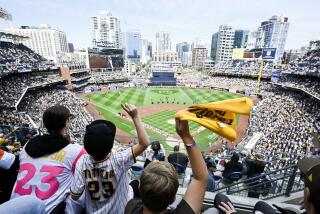Bad Boys Have Rusty, Worn Motor Humming
- Share via
DETROIT — This is a tough city, with tough people. It has been called Motor City, and it has been called Murder City, but no one has ever dared call it a pretty city.
In fact, one of the popular T-shirts in town proclaims: “Detroit. No place for wimps.” So it’s no wonder that the Detroit Pistons, the Bad Boys of the National Basketball Assn. and the final opponent of the Lakers in their quest for their third consecutive NBA championship, have taken this blue-collar city by storm.
In every other city in the league, the Pistons, beaten by the Lakers for the title last year, are known as cheap-shot artists who bully their way to victory. But here, in this gritty factory town, fans don’t want the good guys to win.
“We kind of like that bad image,” Piston fan Leonard Foster said. “It’s like it is us against the world.”
Equipped with a plush new arena in Auburn Hills, about 30 miles from Detroit, and the best regular-season record in the NBA this year, the Pistons have become the hottest ticket in town.
“This year, there is no hoping about it, they are going all the way” said Patricia Jordan, a downtown salesclerk.
“I have never seen it like this,” said James Stewart, a waiter at the Lindell AC, downtown Detroit’s premier sports bar. “People are at a fever pitch.” This season, the team became the first Detroit sports franchise to sell out each of its home games. And for the second consecutive year, the Pistons drew more than a million in attendance. No other NBA team has done that.
The new arena, the Palace, has been a boon to the Pistons. It is only a fraction of the size of their previous home, the Silverdome in Pontiac, which is slightly closer to Detroit but was hardly suited to basketball.
The cavernous Silverdome was built for the Detroit Lions and seats about 75,000 for football. The Pistons used only 22,363 of those seats, leaving lots of wide-open spaces. And at the Silverdome, the Pistons frequently discounted tickets to pull in more fans.
The Palace, designed specifically for basketball and developed and owned by Piston owner William Davidson, seats slightly more than 21,000, and there has been no need to discount tickets.
In fact, prices here are approaching those at the Forum. Before the series began, scalpers were asking $200 to $400 for average seats, with seats near the floor reportedly going for as much as $1,000.
But other entrepreneurs are trying to cash in on the Pistons, as well. The Bad Boys image has been turned into a lucrative marketing tool. Bad Boys T-shirts, hats and handkerchiefs are on sale throughout the city.
The two Bad Boys with the worst reputations, center Bill Laimbeer and forward Rick Mahorn, are quietly using their negative image to become the two good guys in charity work.
They bought the rights to a photograph in Rolling Stone magazine that showed them in leather and sunglasses, with Mahorn chomping on a basket and Laimbeer crushing a ball. They have turned it into a poster, which sells for $5 a copy, and are donating the proceeds to charity.
But not everyone in town is happy about the Pistons’ success since their move to Auburn Hills. Some black leaders were angered by the Pistons’ move even farther from the city, and in March, the Rev. James Holley criticized the team for playing “plantation basketball,” with “black people performing for the amusement of upscale whites.”
The Pistons denied Holley’s charges, noting that the team hasn’t played in the city since leaving for the Silverdome before the 1978-79 season.
Although the team’s leading black players dismissed Holley’s charges, some fans in the city--both black and white--agree that the Pistons have become a team for the rich.
“You’ll find that a lot of people in Detroit haven’t been out to Auburn Hills,” said Eddie Mata at the Lindell AC. “It’s out there in the boondocks, and it’s just too hard to get to from the city. I think 95% of the people who go are suburbanites.”
But for now, nobody’s quibbling. For the rest of the series at least, city-dwellers and suburbanites, blacks and whites, are ecstatic that the Bad Boys are in the neighborhood.
More to Read
Go beyond the scoreboard
Get the latest on L.A.'s teams in the daily Sports Report newsletter.
You may occasionally receive promotional content from the Los Angeles Times.










